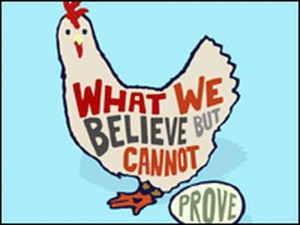You Can’t Reverse Engineer The Google Algorithm

As most SEOs are aware, Google just launched the latest penguin algorithm. Amid the mass panic that follows all algorithm updates, several SEOs started discussing the Google algorithm and their theories. Don’t worry, I’m not going to tell you how to recover from it or anything like that. Instead, I want to focus on some of the discussion points I saw flying around the web. It’s become clear to me that an overwhelming majority of SEOs have very little computer science training or understanding of computer algorithms. I posted a rant a few weeks ago that briefly touched on this, but now that I can actually type (no more elbow cast!) I’d like to delve a bit deeper into some misconceptions about the Google algorithm.
It’s always been my belief that SEOs should know how to program and now I’d like to give a few examples about how programming knowledge shapes SEO thought processes. I’d also like to add the disclaimer that I don’t work at Google (although I was a quality rater many years ago) and I don’t actually know the Google algorithm. I do have a computer science background though, and still consider myself a pretty good programmer. I’ll also argue (as you will see in this post) that nobody really knows the Google algorithm – at least not in the sense you’re probably accustomed to thinking of.
SEOs who’ve been at it for a while remember the days of reverse engineering the algorithm. Back in the late 90s, it was still pretty easy. Search engines weren’t that complex and could easily be manipulated. Unfortunately, that’s no longer the case. We need to evolve our thinking beyond the typical static formula. There’s just no way the algorithm is as simple as set of weights and variables.
You can’t reverse engineer a dynamic algorithm unless you have the same crawl data.
The algorithm isn’t static. As I mentioned in my rant, many theories in information retrieval talk about dynamic factor weights based on the corpus of results. Quite simply, that means that search results aren’t ranked according to a flat scale, they’re ranked according to the other sites that are relevant to that query. Example: If every site for a given query has the same two word phrase in its title tag, then that phrase being in the title won’t contribute highly to the ranking weights. For a different search though, where only 20% of the results have that term in the title, it would be a heavy ranking factor.
What we do know is that there are 3 main parts to a Google search. Indexing, which happens before you search so we won’t cover it here, result fetching, and result ranking. Result fetching is pretty simple at a high level. It goes through the index and looks for all documents that match your query. (there’s probably some vector type stuff going on with mutltiple vectors for relevancy and authority and what not, but that’s way out of this scope.) Then, once all the pages are returned, they’re ranked based on factors. When those factors are evaluated, they’re most likely evaluated based only on the corpus of sites returned.
I want to talk about T trees and vector intersections and such, however I’m going to use an analogy here instead. In my earlier rant I used the example of car shopping and how first you sort by class, then color, etc – but if all the cars are red SUVs you then sort by different factors.
Perhaps a better way is to think of applying ranking factors like we alphabetize words. Assume each letter in a word is a ranking factor. For example, in he word “apple” the “a” might be keyword in title tag. The “p” might be number of links and the “e” might be something less important like page speed (Remember when Cutts said “all else being equal, we’ll return the faster result? that fits here.) Using this method, ranking some queries would be easy. We don’t need many factors to see that apple comes before avocado. But what about pear and pearl? In the apple/avocado example, the most significant (and important) ranking factor is the 2nd letter. In the pear example though, the first four factors are less important than the l at the end of the word. Ranking factors are the same way: They change based on the set of sites being ranked! (and get more complicated when you factor in location, personalization, etc – but we’ll tackle all that in another post.)
It’s not just dynamic, it’s constantly learning too!
For a few years now I’ve had the suspicion that Google is really just one large-scale neural network. When I read things like this and then see the features they just released for Google+ images, I know they’ve got large-scale neural nets mastered.
http://reborn-babies-dolls.com/custom-reborn-baby-dolls/ What’s a Neural Network? Well, you can go read about it on Wikipedia if you want, but quite simply a neural network is a different type of algorithm. It’s one where you give it the inputs and the desired outputs, and it uses some very sophisticated math to calculate the best and most reliable way to get from those inputs to the outputs. Once it does that, you can give a larger set of inputs and it can use the same logic to expand the set of outputs. In my college artificial intelligence class (back in 2003) I used a rudimentary one to play simple games like nim and even to ask smart questions to determine which type of sandwich you were eating. (I fed it in a list of known ingredients and sandwich definitions, and it came up with the shortest batch of questions to ask to determine what you had. Pretty cool) The point is that if I could code a basic neural net in lisp on a pentium1 laptop 10 years ago, I’m pretty sure Google can use way more advanced types of learning algorithms to do way cooler things. Also, ranking link signals is WAY less complicated than finding faces and cats in photos.
Anyway.. when I think of Penguin and Panda and hear that they have to be run independent of the main search ranking algorithm, my gut instantly screams that these are neural nets or similar technology. Here’s some more evidence: From leaked documents we know that Google uses human quality raters and that some of their tasks involve rating documents as relevant, vital, useful, spam, etc. Many SEOs instantly though “OMG, actual humans are rating my site and hurting my rankings.” The clever SEOs though saw this as a perfect way to create a training set for a neural network type algorithm.
By the way, there’s no brand bias either
Here’s another example. Some time ago @mattcutts said “We actually came up with a qualifier to say OK NYT or Wikipedia or IRS on this side, low quality sites over on this side.” Many SEOs took that to mean that Google has a brand bias. I don’t think that’s the case. I think what Matt was talking about here was using these brand sites as part of the algorithm training set for what an “authoritative” site is. They probably looked at what sites people were clicking on most or what quality raters chose as most vital and then fed them in as a training set.
There’s nothing in the algorithm that says “rank brands higher” (I mean, how does an algorithm know what a brand is? Wouldn’t it be very easy to fake?) – it’s most likely though that the types of signals that brand sites have were also the types of signals Google wants to reward. You’ve heard me say at countless conferences: “Google doesn’t prefer brands, people searching Google do.” That’s still true and that’s why brand sites make a good training set for authority signals. When people stop preferring brands over small sites, Google will most likely stop ranking them above smaller sites.
We need to change our thought process
We really need to stop reacting literally to everything Google tells us and start thinking about it critically. I keep thinking of Danny Sullivan’s epic rant about directories. When Matt said “get directory links” he meant get links for sites people visit. Instead, we falsely took that as “Google has a flag that says this site is a directory and gives links on it more weight, so we need to create millions of directories.” We focused on the what, not the why.
We can use our knowledge of computer science here. It’s crucial. We need to stop thinking of the algorithm as a static formula and start thinking bigger. We need to stop trying to reverse engineer it and focus more on the intent and logic behind it. When Google announces they’re addressing a problem we should think about how we’d also solve that problem in a robust and scalable way. We shouldn’t concern ourselves so much with exactly what they’re doing to solve it but instead look at the why. That’s the only true way to stay ahead of the algorithm.
Ok, that’s a lot of technical stuff. What should I take away?
- You can’t reverse engineer the algorithm. Neither could most Googlers.
- The algorithm, ranking factors, and their importance change based on the query and the result set.
- The algorithm learns based on training data.
- There’s no coded-in “brand” variable.
- Human raters are probably a.) creating training sets and b.) evaluating result sets of the neural network style algorithm
18 comments May 23rd, 2013



